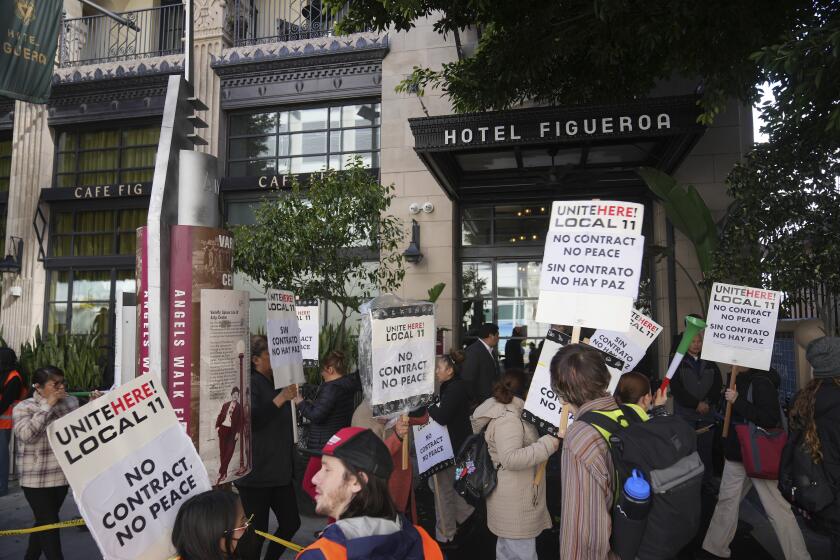Gloomy Fed employment forecast overshadows upbeat GDP data
The American economy grew faster in the third quarter this year than previously estimated, but that bit of encouraging news was overshadowed by a grim new forecast from the Federal Reserve that predicted unemployment would remain at about 9% next year and stay high for years to come.
The pessimistic long-term outlook underscored the possibility that the United States — after years of good times that cast a rosy glow over the American dream and raised personal expectations for the future — may now be headed for a grayer, more financially constricted decade or more.
Such a development not only carries major political implications but threatens the prospects for millions of ordinary Americans, from young people seeking to start careers and families to older people facing the prospect of seeing their golden years less golden.
In fact, some Fed policymakers on Tuesday raised the specter of a permanently higher jobless rate for the U.S. economy, suggesting that many more workers will struggle to get back on their feet even as the economy continues to grow.
The Fed’s forecast is an acknowledgment that the “healing process in the economy has slowed to a crawl,” said Ethan Harris, an economist at Bank of America Merrill Lynch.
The central bank’s predictions were released Tuesday as part of the minutes of its early November meeting, when the institution also approved its controversial bond-buying program to spur economic growth.
The nation’s unemployment rate has been stuck at 9.6% since August.
Just a few months ago, Fed officials were more optimistic about the road ahead — for jobs and the overall economy. But now they see the economy growing by about 2.5% this year, not enough to make a dent in unemployment.
And next year, policymakers said, the economy was likely to increase 3% to 3.6%; their previous forecast in June called for growth of as much as 4.2%.
The Fed’s downgraded outlook was released hours after the government reported that economic growth in the third quarter was slightly higher than previously thought. The Commerce Department revised economic growth upward in the July-to-September period to an annual rate of 2.5%. The earlier estimate had been 2%.
The GDP revision was an encouraging sign, as gross domestic product, the broadest measure of economic activity, showed a marked improvement from the anemic 1.7% growth rate in the second quarter. Revisions showed stronger gains in consumer spending, exports and business investments.
Even so, analysts say GDP growth of at least 3% is needed to bring down the jobless figure — and many don’t expect the economy to perform that well in the fourth quarter or early next year.
One major problem is the fading benefits from the Obama administration’s $800-billion economic stimulus package passed nearly two years ago. Republicans have attacked the program ever since, and President Obama has avoided calling for a new one.
Economists also worry that consumer spending may weaken. Confidence remains low, and unemployment benefits, which have helped prop up spending, probably won’t be extended by lawmakers, given the new political sensitivity to big government deficits. Hundreds of thousands of jobless workers will see their benefits expire this month.
But the biggest single drag on growth may be the state of the labor market. Even the more optimistic independent economists say unemployment will decline slowly, starting most likely
in the second half of next year.
“I think momentum will build gradually,” said Ken Matheny, a senior economist at Macroeconomic Advisers, a forecasting firm based in St. Louis.
Analysts said they were encouraged by the continuing strong profits of American businesses. Tuesday’s report showed corporate profits jumped 28% in the third quarter from a year earlier to an annualized total of $1.66 trillion. That’s a record high and reflects deep cost cutting and increases in demand for goods and services.
With surging profits, businesses have built up mountains of cash on hand, and their spending for equipment and software rose an upwardly revised 16.8% in the third quarter.
But thus far, many companies have been reluctant to add workers.
“The problem is the corporate business leaders don’t have a lot of confidence in the economy or in Washington,” said Harris, noting that executives remained concerned about tax and other policy uncertainties in Washington.
Consumer spending, which accounts for about 70% of the American economy, may also be held back as people pay off debts and pull back after years of overconsumption.
Tuesday’s report showed personal incomes and the savings rate were higher than earlier estimates. The U.S. personal saving rate — the share of after-tax income that isn’t spent — was 5.8% in the third quarter, in contrast to rates approaching zero just a few years ago.
Unlike past recoveries, the current one isn’t getting any help from the home-building industry, which remains depressed.
On Tuesday, the National Assn. of Realtors said existing home sales fell 2.2% in October from the prior month and were 26% below their level in October 2009, when sales were being fueled by a tax credit for buyers.
Michael D. Larson, a housing analyst at Weiss Research, said the figures indicate the market is stagnating because of the high level of unemployment and uncertainty over a jobs recovery.
The national median price for previously owned homes was $170,500 in October, down 1% from a year earlier. Foreclosures and other distressed properties accounted for 34% of the market last month, compared with 35% in September and 30% last year.
With the housing market limping along, UCLA economist Ed Leamer doesn’t see the economy growing at a robust pace any time soon. He expects the unemployment rate to tick higher in the coming months and believes that even the Fed’s more-pessimistic projections for unemployment may be too rosy.
Some Fed policymakers said the long-term jobless rate might rise to nearly 6% from the historical figure of close to 5%, reflecting the view that some of the problems with high unemployment are structural in nature, in which worker skills and employer needs don’t match up.
With more robots, computers and foreign workers replacing them, “American workers are facing intense competition like they’ve
never seen before,” Leamer said.
Growth in U.S. exports may help create more jobs, he said, but that means reversing a decades-long pattern of importing more than exporting.
In the third quarter, the nation’s big trade deficit cut GDP growth by more than half.
“We’re getting demand, but a lot of that demand leaks to foreign producers,” he said.
Times staff writer Alejandro Lazo in Los Angeles contributed to this report.
More to Read
Inside the business of entertainment
The Wide Shot brings you news, analysis and insights on everything from streaming wars to production — and what it all means for the future.
You may occasionally receive promotional content from the Los Angeles Times.











